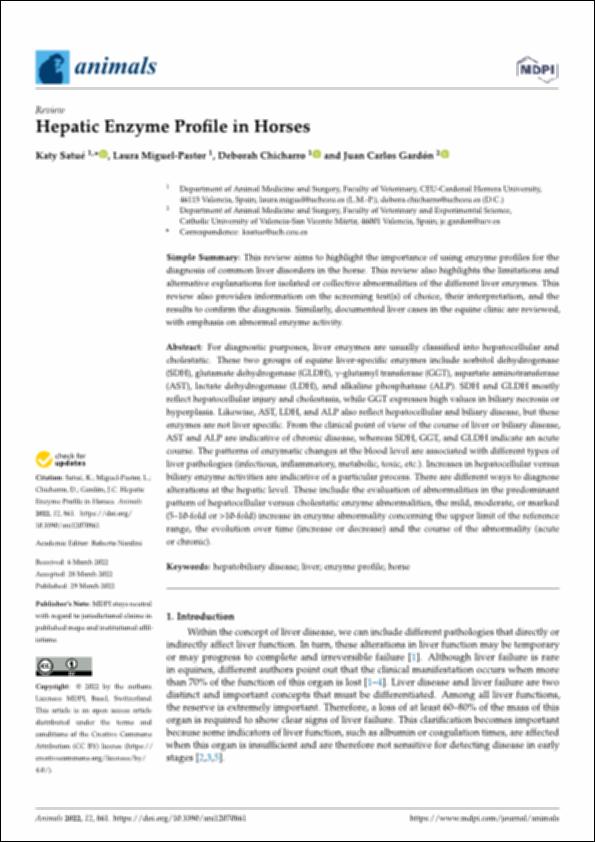Por favor, use este identificador para citar o enlazar este ítem:
http://hdl.handle.net/10637/14147Hepatic enzyme profile in horses
| Título : | Hepatic enzyme profile in horses |
| Autor : | Satué Ambrojo, Katiuska Miguel Pastor, Laura Chicharro Alcántara, Deborah Gardon Poggi, Juan Carlos |
| Materias: | Horses - Digestive organs - Diseases - Diagnosis.; Caballos - Aparato digestivo - Enfermedades - Diagnóstico.; Liver cells - Diagnostic use.; Células hepáticas - Uso diagnóstico. |
| Editorial : | MDPI |
| Citación : | Satué, K., Miguel-Pastor, L., Chicharro, D. & Gardón, J. C. (2022). Hepatic enzyme profile in horses. Animals, vol. 12, i. 7 (29 mar.), art. 861. DOI: https://doi.org/10.3390/ani12070861 |
| Resumen : | For diagnostic purposes, liver enzymes are usually classified into hepatocellular and cholestatic. These two groups of equine liver-specific enzymes include sorbitol dehydrogenase (SDH), glutamate dehydrogenase (GLDH), -glutamyl transferase (GGT), aspartate aminotransferase (AST), lactate dehydrogenase (LDH), and alkaline phosphatase (ALP). SDH and GLDH mostly reflect hepatocellular injury and cholestasis, while GGT expresses high values in biliary necrosis or hyperplasia. Likewise, AST, LDH, and ALP also reflect hepatocellular and biliary disease, but these enzymes are not liver specific. From the clinical point of view of the course of liver or biliary disease, AST and ALP are indicative of chronic disease, whereas SDH, GGT, and GLDH indicate an acute course. The patterns of enzymatic changes at the blood level are associated with different types of liver pathologies (infectious, inflammatory, metabolic, toxic, etc.). Increases in hepatocellular versus biliary enzyme activities are indicative of a particular process. There are different ways to diagnose alterations at the hepatic level. These include the evaluation of abnormalities in the predominant pattern of hepatocellular versus cholestatic enzyme abnormalities, the mild, moderate, or marked (5–10-fold or >10-fold) increase in enzyme abnormality concerning the upper limit of the reference range, the evolution over time (increase or decrease) and the course of the abnormality (acute or chronic). |
| Descripción : | Este artículo se encuentra disponible en la página web de la revista en la siguiente URL: https://www.mdpi.com/2076-2615/12/7/861 Este artículo de investigación pertenece al número especial "Hepatic Disease of Equids". |
| URI : | http://hdl.handle.net/10637/14147 |
| Derechos: | http://creativecommons.org/licenses/by/4.0/deed.es |
| ISSN : | 2076-2615 (Electrónico) |
| Fecha de publicación : | 29-mar-2022 |
| Centro : | Universidad Cardenal Herrera-CEU |
| Aparece en las colecciones: | Dpto. Medicina y Cirugía Animal |
Los ítems de DSpace están protegidos por copyright, con todos los derechos reservados, a menos que se indique lo contrario.


